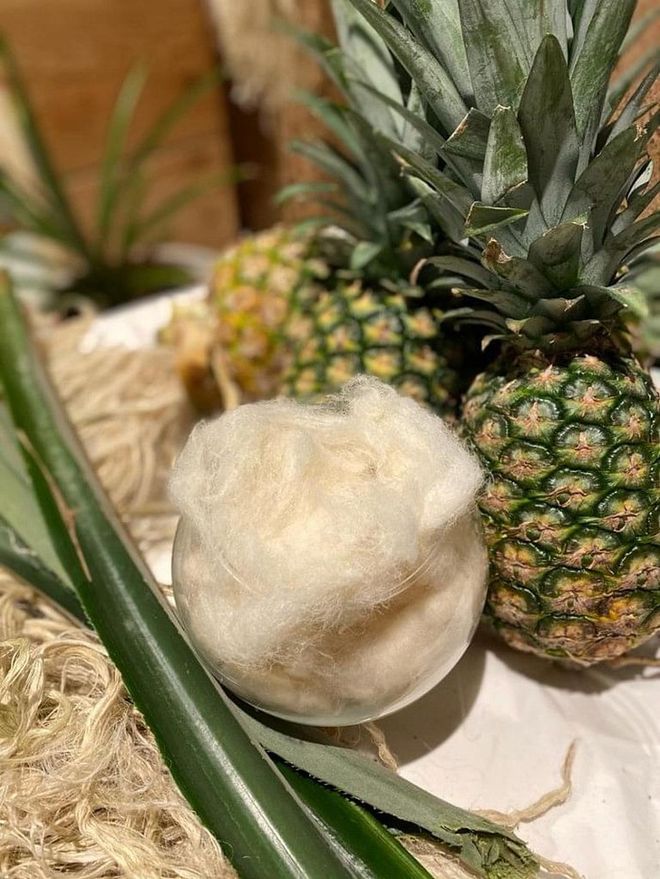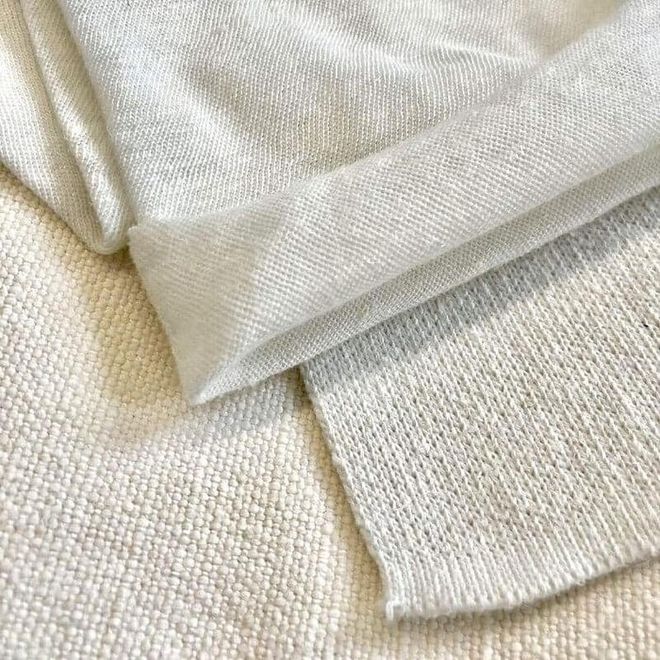Sustainable Loungewear Label NOST Celebrates Heritage Crafts Through Innovation
Reinventing traditional textile art with modern prints and alternative fabrics.

Sustainability is a term that's being bandied around in fashion in recent years, given the industry's staggering impact on the environment. Some brands have taken steps to minimise their carbon footprint, while others have implemented ethical practices. And while it’s not always clear who's actually making a positive change and who's using greenwashing tactics, it's heartening to know that young labels have made it their foremost mission to address multiple environmental and social issues.
Meet NOST, a homegrown label that partners maker families and vulnerable communities to create sustainable loungewear. Its timeless, thoughtfully crafted pieces—think: easy cuts and cosy styles you won't want to change out of—feature architecturally inspired patterns that are delicately printed onto sustainably sourced fabrics by way of age-old handcrafting processes like block-printing, batik-printing and hand-loom weaving.
NOST founders Felicia Toh and Tessa Weiher, who are architecturally trained, currently run the label while holding full-time jobs. Seeking to meld their passion for heritage crafts and fabric innovation, the duo has embarked on a research project, titled PALFCRAFT, that looks into the use of woven pineapple leaf fibre (PALF) yarns and fabrics in artisan-printed apparel and textiles—one of 10 projects as part of DesignSingapore Council's Good Design Research (GDR) initiative that "empowers designers and design enterprises in Singapore to find their unique value proposition in designing for impact through research and experimentation, supported by a wide network of knowledge partners."
We chat with Felicia about NOST's brand philosophy, their take on sustainability, what they hope to achieve with PALFCRAFT, and more.

Tessa Weiher and Felicia Toh.Photo: Courtesy
NOST Tessa Weiher Felicia Toh
How did NOST come about? Why did you decide to focus on loungewear?
NOST was founded in November 2018, and comes from the word ‘nostalgia’, which at its root etymology means ‘a longing for home.’ During travels in Asia, I met with artisan families, incredibly skilled at heritage techniques such as weaving and block-printing, who often create from their homes. The homes in which we had these conversations became the central motif of our brand.
I wanted to begin with loungewear because of its natural resonance with the home space, and also because of the lack of versatile, sustainable loungewear options out there. Could loungewear be stylish and versatile, such that you wouldn’t mind being seen in them while you answer a Zoom call? Beyond loungewear, we also make home goods that make spaces at home just that bit more snuggly. We didn't know when we started the brand just how much time we would be spending at home due to the pandemic.
What is your brand ethos?
NOST’s brand DNA consists of five tenets: Feeling at home, Aspirational, Timelessness, Dignity, and Gentleness. We have immense respect for the skills of generational artisan families based in Asia and exist to be a bridge between makers and markets. Home is a place of rest and calm, of gathering with loved ones and of solitude—we hope our brand encapsulates that quietude.
Related article: 5 Fashion Labels That Launched Sustainable Collections This Season
What factors do you consider when designing your pieces?
Design
We design our textiles from scratch. NOST prints are inspired by architectural textures around us—whether it’s the façade of the Concourse or the spiral staircases in shophouses. We enjoy geometric details and earthy hues.
Raw Materials
We specify the raw fabrics used by our makers. All our loungewear is made of 100 per cent Global Organic Textile Standard (GOTS) certified organic cotton, while dyes used are low-impact and azo-free. Some collections use completely natural dyes made from plants.
Artisan Crafted
The designs are sent to artisans who first carve the blocks by hand in either wood or by welding metal, depending on the process (block-printing or batik-printing). Another group of artisans prepare the colour dyes and carefully stamp on fabric by hand to create the prints. It’s a really deliberate, artisanal approach to creating clothing that takes time and gives value to the garment we hold in our hands. In some ways, that runs counter to the throwaway culture of fast fashion.
Sewing
Our pieces are sewn by our artisans or sewing partners whom we commission for selected collections. The Sapana dresses were sewn by Swahlee, an impact-driven sewing studio based in Assam, India that provides employment to young women who face barriers to ethical, safe employment. Some of our cushions were sewn by Tamar Village, a local Non-Governmental Organisation (NGO) that provides skills training and holistic care to women at risk.
Ethical Practices
We believe that by rethinking the ecosystem of fashion, from who we work with to how it’s made, we can change real lives and real communities on the ground. Designing our pieces from scratch is important because it gives us oversight and agency in curating what goes into the making process. We visit the artisan families first-hand to observe their working conditions and get to know them—these relationships are important to us. For example, our batik artisans based in Pekalongan, Indonesia, employ people from the deaf and mute community in their production team. In addition, by choosing sustainable dyes, we try to do our part to limit our artisans’ exposure to hazardous chemicals—would we want to put our own hands into the dye pot, day in and out, if it contains toxins harmful to health?
How does your background in architecture inform your creations?
Our architectural training hones a certain appreciation of scale, geometry, forms and texture. Our first collection was inspired by buildings in Singapore, abstracted into a series of geometric prints. As architects, it's natural for us to take the city in as we walk around—touching the surfaces or noticing the way a façade is detailed. We bring that same attention to detail into our designs.
How does NOST stand out from other ethical, print-based brands?
Our architectural point of view is naturally something we carry with us in everything we do. Architecture is part of a city’s heritage, and we enjoy abstracting aspects of that into our designs. There’s a certain geometric, formal quality to prints derived from architecture that sets it apart from prints that are more organic and floral in nature. We’ve recently seen growth in the number of brands adopting block-printed textiles in their products, and it's heartening to see that heritage craftsmanship is increasingly appreciated and valued.
Related article: Singaporean Designer Gin Lee Makes Her Mark With Clever Pleats And A Passion To Make Fashion Sustainable
What is your take on sustainability and why is it important to NOST? How do you communicate sustainability through different aspects of your business?
Sustainability is such a big topic. Our approach is to look at it as an ecosystem of production, asking how the moving parts can be rethought. Fast fashion is notoriously pollutive—the second most pollutive in the world after fuels. At NOST, we want to challenge the idea that clothing is disposable and trend driven. We produce collections that are timeless, comfortable and meant to be lovingly re-worn, like keepsakes.
Our artisans have shared with us the difficulties of competing with commercial mass production, and told stories about neighbours who have closed shop—it’s clear that the survival of craft heritage artistry lies in relevance. And sustainability is a big part of that conversation; of bridging heritage craft into the future in a way that is circular and meets modern demand.
Packaging wise, all NOST apparel comes in a rust-hued cotton pouch that can be re-used for toiletries, as a way to reduce single-use plastic. We choose low-impact materials for our loungewear and home goods, such as Tencel and organic cotton, as well as natural and azo-free dyes. When it comes to post-processing, we look out for artisan businesses that treat the water used in their processes prior to discharge. Our Pekalongan-based makers have a filtration system that uses biotopic plants and fish to further cleanse the water after filtration.
What has been most memorable about partnering marginalised artisans and vulnerable communities?
Entering their homes and conversing with them over steaming cups of tea or a meal. These friendships are vital to why NOST was founded.
What are the challenges and limitations when it comes to celebrating heritage craftsmanship in your collections?
Good things take time. We appreciate the hand-crafted quality of the textiles that are woven on a step-loom or hand-printed, which certainly takes longer than digital printing medium. There are tell-tale signs that something has been crafted by human hands—that, we find beautiful. There are also technical considerations when working with craft mediums, such as the spacing required between details to prevent ink bleeds, that informs our journey of understanding more about heritage crafts.
Related article: Meet Tove & Libra, The Sustainable Brand That Aims To Make Fashion Better
Tell us all about the PALFCRAFT project as part of DesignSingapore Council’s Good Design Research initiative.
PALCRAFT is a new research initiative in collaboration with our artisans and NEXTEVO, as part of the Good Design Research (GDR) Grant. The project researches the use of artisan-printed and woven PALF yarns and fabrics in lightweight apparel and textiles.

Pineapple Leaf Fibres (PALF). Photo: NEXTEVO
PALF
PALF is derived from pineapple leaf fibres, an agricultural by-product found abundantly in Southeast Asia. Conventionally burnt away and disposed of as waste, the conversion of PALF into usable textiles creates a circular economy that simultaneously reduces waste, cuts air pollution from burning, and provides the fashion industry with a new, sustainable alternative to fabrics such as polyester and cotton. PALF consumes only 3 per cent of water compared to conventional cotton production. In terms of social impact, PALF also increases the income of PALF farmers by 30 per cent, many of whom live below the poverty line.
This will be a market-first product featuring commercially available PALF fabrics that are printed and woven using heritage artisanal methods of batik-printing and loom weaving. We are excited about PALFCRAFT because of the possibility to put innovative, sustainable pineapple leaf yarns into the hands of artisans, to weave and batik-print new fabrics in a range of NOST designs.

PALF Fabrics. Photo: NEXTEVO
PALF Fabrics
Why is this project important to NOST? What do you hope to achieve with the project?
PALFCRAFT fulfils our vision of bridging makers to markets by combining heritage craft with innovation, which we hope will renew the heritage craft trades. Consumers and hospitality businesses are increasingly on the lookout for sustainable, alternative textiles. In fact, a McKinsey report highlights that 55 per cent of apparel companies surveyed wanted at least half of their products to be made with sustainable materials by 2025. We look forward to the upcoming exhibition where new products will be made using artisanal PALF in signature prints. Hopefully this will inspire hotels and other brands to come forward and adopt PALF textiles in their collections as well.
Related article: Why Luxury Brands Like Hermès And Stella McCartney Are Turning To Mushrooms